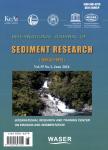THREE-DIMENSIONAL NUMERICAL MODELINGOF COHESIVE SEDIMENT TRANSPORT BY TIDAL CURRENTIN PEARL RIVER ESTUARV
THREE-DIMENSIONAL NUMERICAL MODELING OF COHESIVE SEDIMENT TRANSPORT BY TIDAL CURRENT IN PEARL RIVER ESTUARV出 版 物:《International Journal of Sediment Research》 (国际泥沙研究(英文版))
年 卷 期:1999年第14卷第2期
页 面:107-123页
核心收录:
学科分类:08[工学] 081502[工学-水力学及河流动力学] 0815[工学-水利工程]
主 题:Cohesive sediment Sediment transport model Finite element method Eulerian-Lagrangian method.
摘 要:A three-dimensional numerical model of suspended sediment transport taking into account the effects of cohesiveness between sediments is presented. An efficient operator splitting scheme is employed to solve the equations of mass conservation, momentum and suspended sediment transport. The splitting method partitions a time step into three fractional time steps according to physical phenomena. In the first step, advection and Coriolis force are solved by Eulerian-Lagrangian method (ELM). Horizontal diffusion is approximated by implicit finite element method (FEM) for each horizontal layer in the second step. In the last step, vertical diffusion and pressure gradient are discretized by implicit finite difference method (FDM) for each nodal column. The continuity equation is solved by implicit FEM within an entire time step. The sigma coordinate system for vertical columns and nine-node isoparameteric finite elements for horizontal planes are employed in the model. Empirical functions specifically developed for cohesive sediments in China have been incorporated into the model. The model has been applied to investigate the suspended sediment concentration and seabed evolution in the Pearl River Estuary (PRE) in China. Computed results show that the distribution of sediment concentration and seabed evolution is in agreement with field measurements. In addition, the effect of the size of time step on result is discussed. The computed result shows that larger time steps can be used in this model for saving computation time without losing much accuracy.



